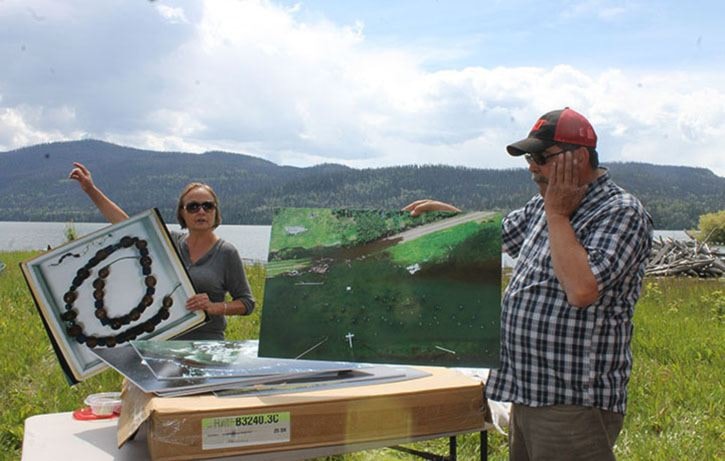Each year, Cheslatta members gather on the shores of the Cheslatta Lake searching for remains of their loved ones.
“Each year the members of our nation re-live that devastation of knowing their ancestors are somewhere out in the lake,” said Cheslatta Carrier Nation Chief Corrina Leween. “My grandparents; great-grandparents; aunts and uncles are amongst the graves that have been washed away.”
In total, since 1952, flooding and erosion have caused over 60 graves to be washed away, and the remains are somewhere in the waters of Cheslatta Lake.
In 1952, Cheslatta Carrier Nation had three large cemeteries on Cheslatta Lake - one at the west end on a high hill, one at Skatchola, and a large cemetery at the Belgatchek village. In total, there were about 200 graves.
These cemeteries were completely inundated in 1952, 1953, 1954, 1955, 1956, 1961, 1976, 1992, 2007, 2010, 2011 and 2015.
“Our people have been dealing with the repetitive flooding of the Cheslatta Lake year after year,” said Leween. “Each time it happens we gather people and go down to Skatchola and Belgatchek and clean up the shoreline; always looking for bones of ancestors.”
According to Mike Robertson, Senior Policy Advisor for Cheslatta Carrier Nation, pieces of caskets and even a human shin bone have been found this year.
Last Tuesday June 16, approximately 30 people joined Cheslatta Carrier Nation leaders on a tour of the Cheslatta Lake system to witness the flooding of the Cheslatta cemeteries, and the impact it has had on the lives of local families.
Burns Lake resident Alan Blackwell, who grew up on the Southside, said he has watched this flood every year since it first started.
“It’s a devastating situation,” said Blackwell. “Every year there are all kinds of human bones floating around in the river.”
“Each Cheslatta member has relatives either buried or washed away and are all affected by the reoccurring flooding of our lands,” said Chief Leween. “This fight for a solution is very personal to me as a leader.”
According to Cheslatta Carrier Nation leaders, the ultimate solution for this yearly flood remains the construction of a cold water release facility at the Kenny Dam. The proposed facility would eliminate the need to flood the Cheslatta Lake system.
“This would allow reservoir water to be released directly into the Nechako River, completely bypassing the Cheslatta system,” explained Robertson.
Cheslatta Carrier Nation signed a memorandum of understanding with the B.C. government in March of this year, laying out the framework for a permanent solution.
Cheslatta Carrier Nation has been engaged in discussions with Rio Tinto Alcan since May 2012, looking at options and solutions. The next meeting with Rio Tinto Alcan is scheduled for July 6, 2015.
Robertson said it's still premature to comment on the July 6 meeting, but said that the community has been pressuring Cheslatta leaders to come to an agreement with Rio Tinto Alcan.
“We will no longer tolerate the lack of attention,” said Robertson. “We are frustrated and angry.”
“We need to get Rio Tinto Alcan and the province of B.C. seriously on board with us to find a solution to the on-going problem,” added Chief Leween.
Kevin Dobbin, Spokesperson for Rio Tinto Alcan, said the company works closely with Cheslatta Carrier Nation, District of Vanderhoof, Nechako Bulkley Valley Regional District and Southside residents, and will continue to do that in order to explore possible options to resolve this issue.
“We remain committed to these discussions and look forward to working with our stakeholders,” Dobbin said.
Meanwhile, the water levels at the Nechako reservoir remain a concern.
The Nechako reservoir level allowance is 2800 feet. Currently, the reservoir is 14 feet of water above the maximum allowance. Rio Tinto Alcan is managing the reservoir through releases at Skins Lake spillway to minimize downstream flooding on the Nechako River.
The spillway flow went up to 500 cubic meters per second on May 26, 2015, but has been reduced to 400 cubic metres per second. According to Robertson, 500 cubic metres per second is the second highest ever sustained flow.
“The reservoir elevation concerns us because the possibility of a heavy rain could raise levels dramatically and cause catastrophic releases,” he said.
Understand the situation
The annual flooding of the Cheslatta system is due to Nechako reservoir’s elevation management flows.
The Kenny Dam was built in 1952 to create a water reservoir to supply downstream hydro-electric turbine to power the Rio Tinto Alcan aluminum smelters. More than 120,000 acres of land were flooded, creating the Nechako reservoir.
Since the Kenny Dam was built and the Skins Lake spillway was constructed to release water from the Nechako reservoir into the upper Nechako River, high water flows and massive erosion have caused extensive flooding of the Cheslatta Lake waterway system.
The constant influx and retreat of water levels mean that buried graves are occasionally exposed. During the original flooding of the lake and river system, coffins were seen floating on Cheslatta Lake and bones washed up along the shoreline. Since then, Cheslatta gravesites have frequently been disturbed by the regular flooding of the Cheslatta system.
